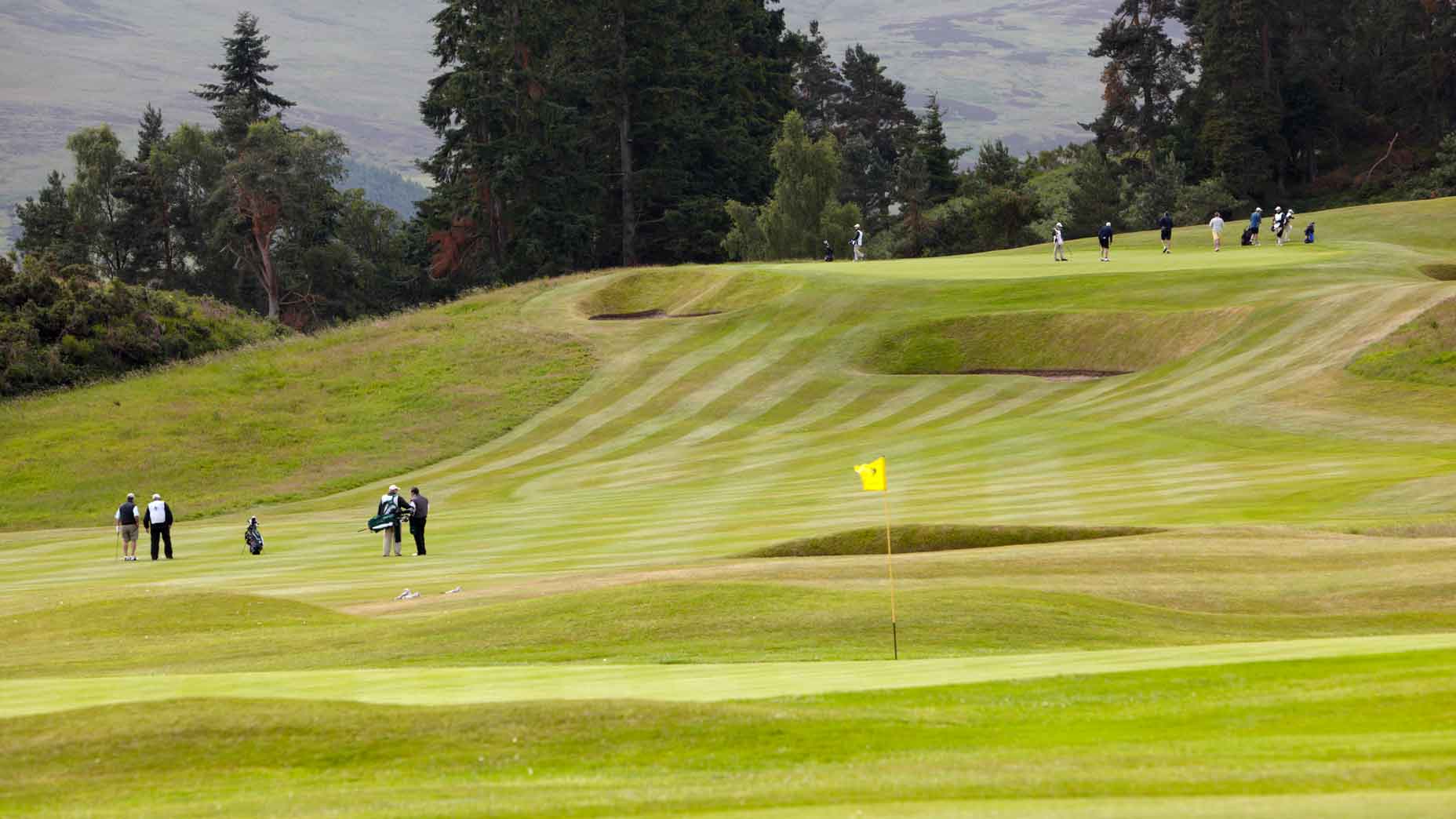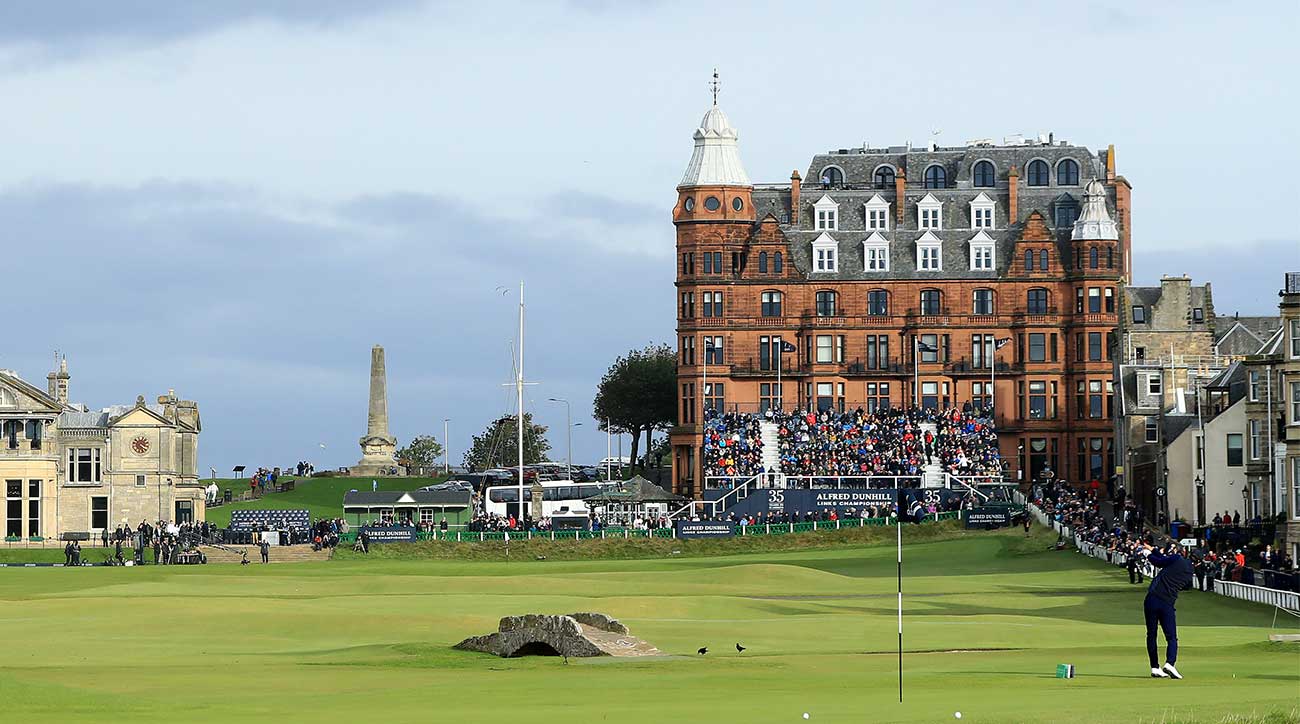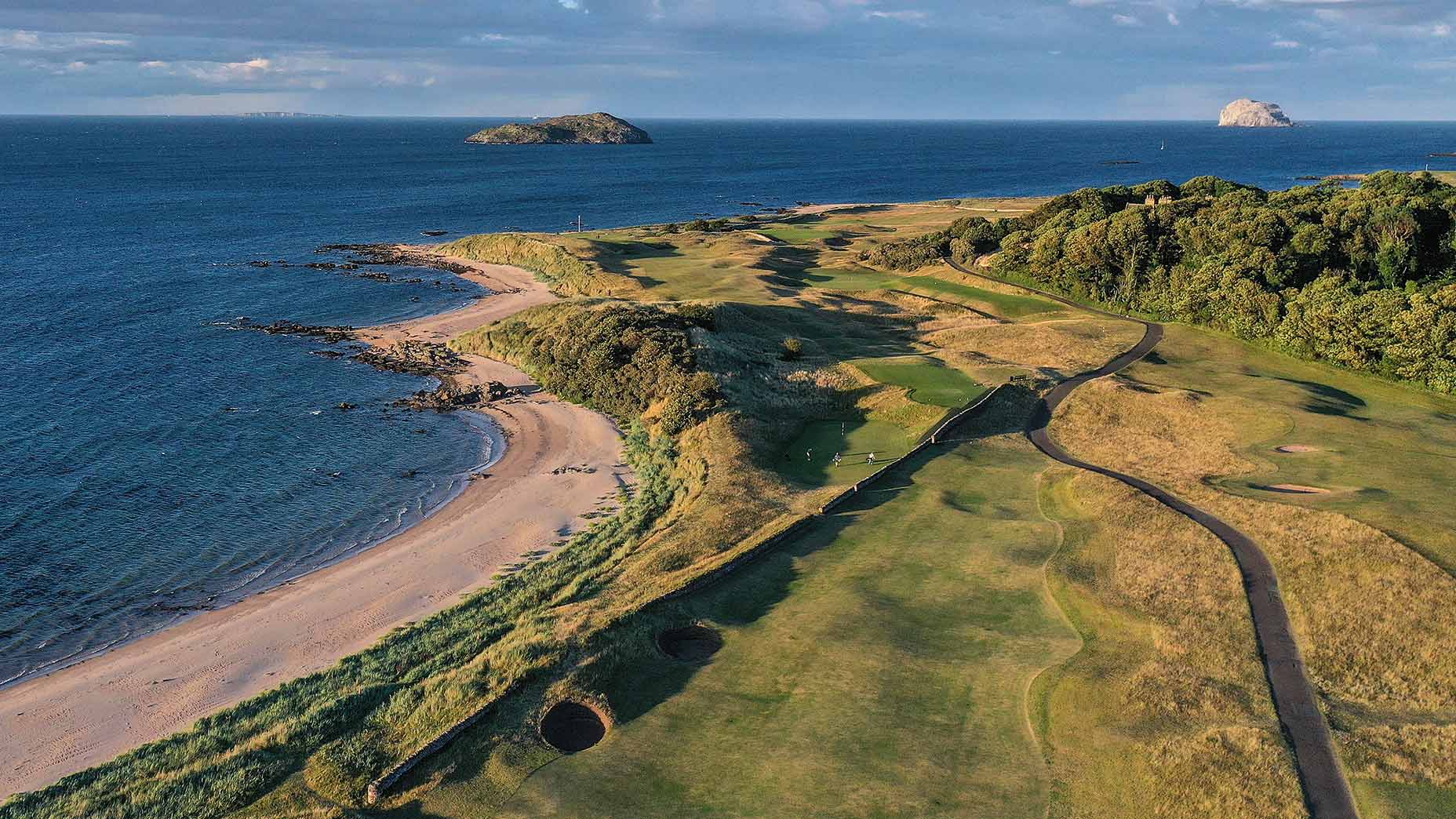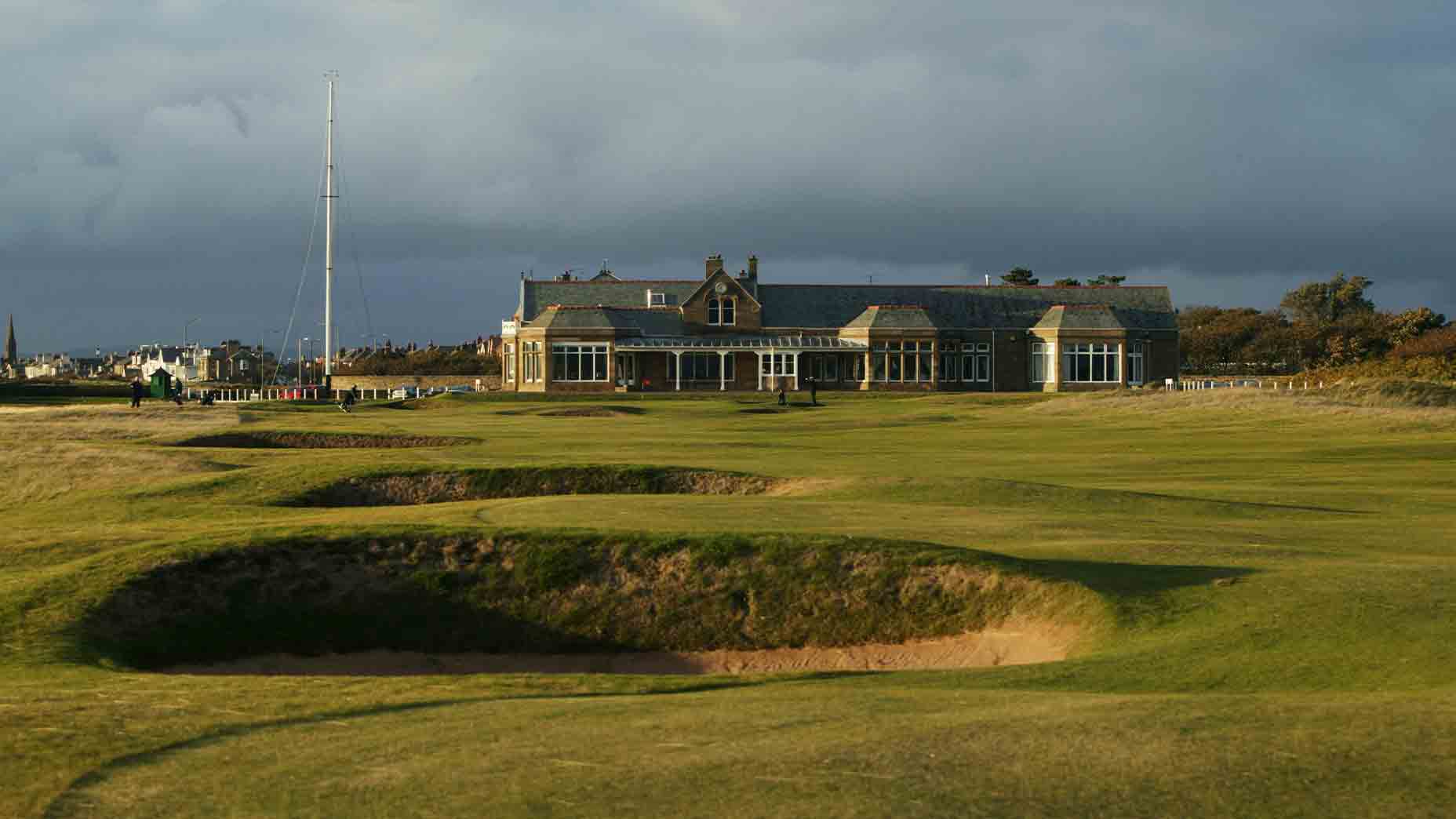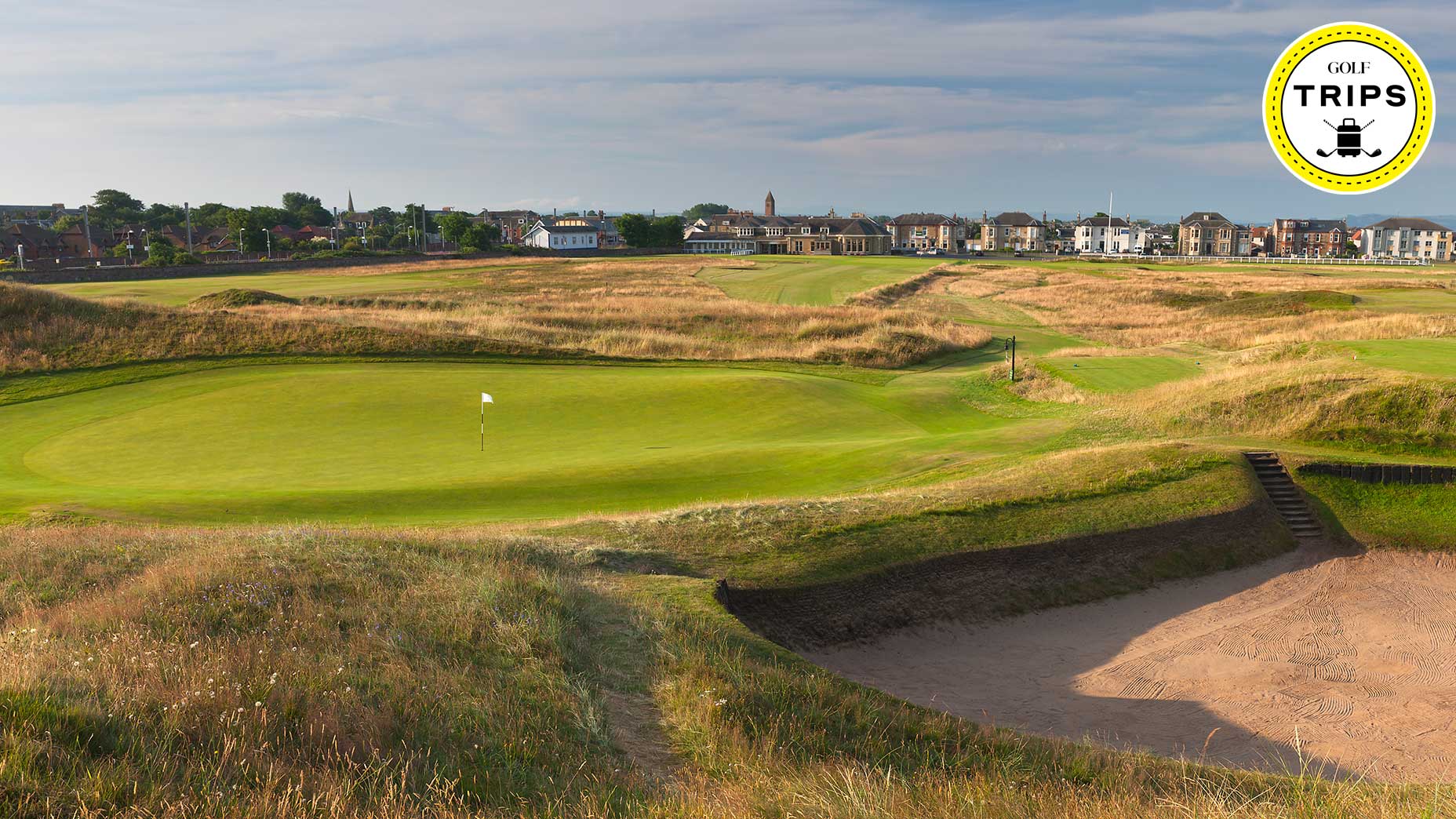1 unforgettable round, and breaking tradition on a world-famous course

A father and son hoped to play a bucket-list round at Lahinch, but to do so, they needed help from the club. What happened next shocked them.
Larry Lambrecht
This past summer, my son Jamie and I made plans to play the Old Course at Lahinch — something we have dreamed about ever since I became an Irish citizen in 2016. (Both my maternal grandparents are from County Mayo.) But it wasn’t until a few days after I made the booking that I saw the notice on the website — and I should have seen it immediately, since it is in boldface with the key word italicized and underlined: The Old Course & Castle Course are both walking courses and golf carts/buggies are not available for hire.
Jamie is 32 and has Down syndrome. He has never walked a course longer than a pitch-and-putt layout; he has flat feet and does not walk quickly, and Lahinch features some difficult terrain. I told Jamie I would cancel our tee time and make other plans, but Jamie refused to hear of it. “Michael!” he replied indignantly. “We have to play Lahinch.” I was doubtful; I didn’t think he knew what he was in for, and I turned out to be right about that.
Jamie doesn’t hit the ball far enough to make par on par 4s or 5s, though he has managed to bogey a few; he has a couple dozen legit pars on par 3s as well as two birdies, one of which involved a putt that inexplicably glanced off my foot after a pin-high 5-wood 160 yards downhill, the other of which culminated in a delicate four-foot downhill putt on a pitch-and-putt course after a dead-aim 9-iron of 75 yards. He played Special Olympics golf for two or three years, but tired of it; he didn’t like teeing up 100 yards from the green and playing such a straitened version of the game. Jamie, being Jamie, wanted to play from the real tees. But we don’t really keep score — we just make a note of all the holes we play well. Gradually, we have managed to create and sustain a very rare thing: golf without aggravation.
Idyllic as this state of affairs can be (and golfers reading this might find it altogether implausible), I was not sure our attitude would fly at Lahinch, so my warmup rounds were mostly riddled with anxiety. At first I was Mr. Aerosol off the tee, spraying balls everywhere. Lahinch demands low, straight, reliable drives; I could be in for a very long, cringey day. Hoping to get in one last practice round, I booked a round at Galway Bay Golf Resort the day before Lahinch, thinking that I could work out the kinks there. (Galway Bay allows the use of carts, so I got one and a caddie as well, for the benefit of whatever advice he might have.) The practice range was encouraging: everything I hit looked good, and our caddie was full of enthusiasm. But on the course, the wheels kept coming off. Weirdly, my drives were low and straight, but I couldn’t hit anything else with any consistency. I began to wonder: would I now have to redesign my swing from scratch? Or was I embarking on a complete meltdown in the mode of Ian Baker-Finch? On a long par 3 it took me four — four! — tries to get off the tee with a playable second shot. Yeah, it was pin high and twenty feet from the hole, but the first three attempts had our caddie wincing.
Meanwhile, Jamie acquitted himself well and earned the caddie’s sincere admiration. “You two play like best friends,” our caddie said. “It’s a fine thing to see.” But that evening over dinner, I told Jamie that if I continued to play as I did that day, I would have to give up the game altogether. (When we got back to the States, I shot an eight-over-par 80 with two lipped-out ten-foot putts on Penn State’s White Course. Freed at last from the pressure of preparing for Lahinch, I hit eleven greens in regulation, parring the first and the last four holes in a row. So I am not giving up the game after all.)

We arrived at our hotel in Lahinch about three hours before our tee time, then had a light lunch and bought matching black Lahinch Golf Club polo shirts; we had dressed for cold rainy weather but it was inexplicably warm and sunny, and amazingly, it stayed warm and sunny all day. (We had been told that one of the charms of Irish golf is that you get to play in all four seasons at once.) We showed up on the course around two o’clock, having been advised by a friend to arrive early, warm up thoroughly, and shake out the jitters — and one of us was very jittery indeed. We were directed to the starter on the first tee, a compact, wiry man named Tony Molloy. Think 1980s Robert Fripp with a clipboard.
I had my spiel for Tony all prepared. It was a version of the spiel I offer anytime Jamie and I are playing with someone we don’t know: this is my son Jamie. He plays a very casual version of the game, and he plays from the front tees. We have a liberal mulligan policy, but we don’t have to use it very often. He plays quickly — he doesn’t stand over the ball all day. And he has surprisingly soft hands around the green. This last bit is meant to suggest that even though he plays a very casual version of the game, he can play it well every now and then, just like his father. I have found that golfers generally don’t expect people with Down syndrome to have a soft touch for the short game; most golfers don’t expect people with Down syndrome to be able to play at all. And Jamie is broad-shouldered and very strong, so attributing soft-handedness to him seems thoroughly counterintuitive. The Lahinch version of my spiel included an extra clause: I’ve looked at the flyover videos on your website, and I know there are a few holes whose tee shots are going to be too challenging for Jamie. When he played Special Olympics golf they had players tee off from the fairway, and I hope that will be all right with you for those holes.
I gave Tony the spiel. Tony looked at Jamie with obvious alarm. Jamie smiled back brightly. “He’s going to have to walk the course, you know that,” Tony said. “I do,” I said. “He’s all ready.” Jamie nodded as he put on his golf gloves.
Tony seemed unconvinced. “I have to warn you: this is a serious course.”
Damn, I thought. Here it comes. They’re not going to let him play.
But I kept calm and replied brightly, “Oh yes, I’m very aware that this is a very serious course and a serious physical challenge. Jamie and I have talked about that. When I made this reservation a few months ago, I didn’t realize you had a no-buggies policy, and then I found out a bit later. I told Jamie we would cancel, but he insisted. ‘Michael,’ he told me, ‘we have to play Lahinch.’ But if he can’t manage it after a few holes, we’ll understand. We don’t want to hold anybody up.”
Tony looked at the ground intensely for a few seconds, then at Jamie again. I waited for him to heave a sigh and tell us how very sorry he was, that Lahinch is just not a suitable course for golfers like Jamie. Or, more to the point, that Jamie was just not a suitable golfer for a course like Lahinch.
“All right,” Tony said at last. “I’m going to make an executive decision. Come with me.”
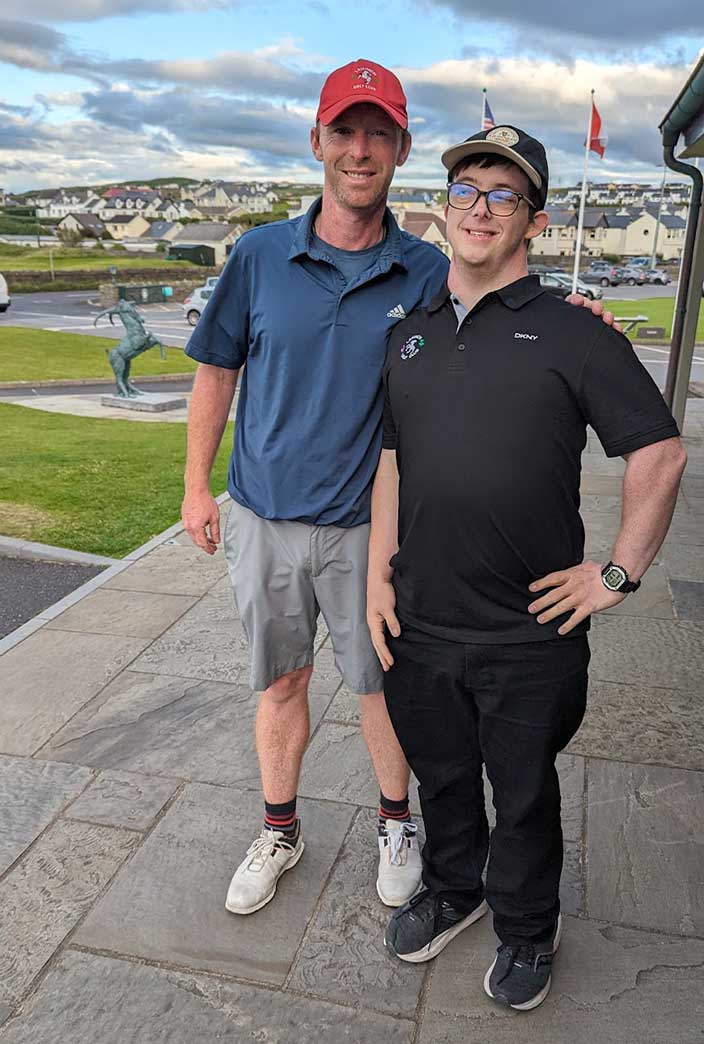
I couldn’t read this response at all. I dutifully followed Tony to the club’s offices on the other side of the first tee, in a long low building that also houses the caddie shack, and waited outside with a gut-churning mixture of apprehension and dread. After a few minutes, Tony re-emerged from the building, visibly emotional, eyes slightly moist. I braced myself: how very sorry….
“I’ve made an executive decision,” he said again. “Here’s what we’re going to do. Your son will have a buggy and his caddie will drive it. I’m going to get you the most experienced caddie we have available. We’re going to make sure he can play this course.”
My heart leapt into my throat. “Uhhh … that’s, uhhh … I mean,” I said, trying to form actual words, “isn’t that a kind of historic exception we’re talking about?” Kind of, yes, in the sense that it had never been done in the 130-year history of the Old Course.
Tony turned to me with a fierce expression and an extended index finger. “There’ll be no cancellations today,” he said.
“Oh my gosh,” I stammered. “Thank you. Thank you.” Now the moist-eye phenomenon was getting contagious.
Tony led me back to the first tee. “Now, I’ll get your caddie and your buggy squared away. You two make your way to the pitching range and work away, and I’ll see you back here at your time.” Turning to Jamie, he said, “Jamie, we are going to give you the VIP treatment today.”
Jamie smiled warmly and did a little fist-pump. “VIP, oh yeah,” he said.
“Jamie,” I squeaked, “Tony says you can ride in a cart! I will walk and your caddie will drive you!”
Jamie’s very expressive eyebrows shot up an inch. “Really! Awesome!” And it was awesome. Really. There would be no cancellations that day.
What struck me immediately, forcefully, was that Tony’s reaction was not tinged with any sense of pity or condescension — and after more than thirty years with Jamie, I can sense that sense even if there are only a few parts per million of it in the air. When Jamie and I returned from the pitching range, Tony introduced us to our caddie, Dave O’Brien, a tall, lean man who seemed to be in his late thirties or early forties. I started to give Dave the Jamie spiel, but he assured me that he understood how Jamie would play and would make sure that he enjoyed his round. As Jamie took his seat in the buggy, Tony said again, “all right now, Jamie, this is the VIP treatment. You go and have a good time and play some great golf, now.”
Jamie proceeded to do just that — have a good time and play some occasionally great golf. First we introduced ourselves to our playing partner, Jim Hunt from South Carolina, who was accompanied by his wife Teena, not playing but recording his round on video. We had gotten the approval of Tony Molloy and presumably the officials of Lahinch Golf Club (I assumed that was what Tony’s discussion in the office was about), but was this arrangement going to be OK with the Hunts, or were we in for four or five awkward hours? That question answered itself on the second hole, as Jamie smacked a plausible drive onto the short grass. At which point Jim Hunt came up to me and said, “I just want to tell you … I feel so relaxed playing with your son.”
“I know what you mean,” I replied. “Ordinarily, so do I. But I’m kind of keyed up right now. I’ll try to settle down.”
“I just mean that we didn’t know what kind of twosome we were joining,” Jim explained, “and I was worried that it might be a pair of golf tourists who were so crazy intense about the game that I wouldn’t be able to enjoy myself.”
“Oh, right,” I laughed. “Yeah, well, we’re pretty much the opposite of that.”

I didn’t manage to settle down for another half hour, opening with a hideous 9-7-7. Then came the fourth hole, which had struck fear into me when I saw it in the flyovers. “Klondyke,” one of the most famous holes in Ireland (if not the world), is a short (470-yard) par five with a fairway the width of a hallway runner weaving through rolling hills of fescue; its distinguishing feature is a massive dune, twenty-five or thirty feet high, that runs across the fairway a little over 300 yards from the tee and leaves you with a blind second shot. Lahinch stations someone at the top of the dune with red and green flags indicating whether it is safe to hit.
Thankfully, I hit my first good shot of the day: a perfectly straight, low drive just off the fairway to the right, in short, playable rough. Jamie needed a few tries to get off the tee successfully, but Dave made it clear this was perfectly OK with him. And then after we walked (and Jamie rode) to our tee shots, we all waited seven or eight long minutes for the green flag to appear at the top of the dune of doom. Dave advised me not to think about the green (or the dune!), just to lay up and take the longest club with which I could clear the dune. “So, a six-iron?” I suggested. “Six is good,” Dave replied, and I proceeded to hit a nice draw that just cleared the top and then rolled to about forty yards from the green.
Now to put the practice range into practice, I thought. I am not good at half- and quarter-swing wedges, and it is not often that I hit three good shots in a row. But I did this day, and bump-and-rolled a little quarter-swing pitching wedge ten feet past the hole. And then hit the putt coming back, dead center of the cup. A birdie! On Klondyke! At Lahinch! Jamie exclaimed with glee, calling it a hole in one. That it was not, but it took the pressure off: I now had a measure of credibility. I could play this game.
I checked the scorecard: hole number 4 was index 18. Ha! Apparently this fearsome thing was the easiest hole on the course. I didn’t care — I had myself a birdie. And for the next four hours, I managed to relax and savor playing this magnificent course with Jamie.
Jamie, for his part, was his usual charming self, and on the also-famous blind-shot fifth hole, “Dell,” laced a lovely 5-wood to the back of the green and three-putted for bogey from fifty feet. That three-putt aside, he did indeed demonstrate that he has surprisingly soft hands around the green, hitting a number of nearly-perfect pitches and holing a couple of putts of ten feet or so. His lag putting was even more impressive: the previous day at Galway, he had hit two eighty-foot putts to within two feet, and at Lahinch he picked up where he left off. Dave was keeping score for him, and doing it the same way I do it — casually. Jamie kept up a running commentary with Dave about club selection, making it clear that he knew what he was doing and that he tries to make sure to hit every club in the bag.
Another highlight: the thirteenth hole, “Mine,” a very short (267-yard) par four. Getting into birdie territory on 13 is easy: all you have to do is hit a perfectly straight drive to a minuscule landing area, avoiding the bunkers on the left and the little valleys of death on the right. I did just that, leaving myself about twenty yards to the green. “I’d putt that myself,” Dave said, “but you’re good with a wedge, so…” Fortified by the not-entirely-true compliment, I ran the ball to within twelve feet, and then missed the putt left by a couple of inches.
“OH oh oh,” cried Jamie, as he does for near misses, throwing his arms over his head. “It’s OK, sweetie,” I replied. “A tap-in par is always a happy thing. And besides, I can count on my hands the number of times I have had two birdies in one round. It’s not something I expect to do.” Jamie proceeded to tell everyone the story of how I got three birdies in a row in 2021 — just three weeks after I eagled a par four. (He told that story too.) It was heartbreakingly clear that he is very proud of my flashes of competent golf, even if they’re never more than flashes.
“The thing is,” I said to Jim when he remarked again, walking down the seventeenth fairway, on how pleasant it was to play with Jamie, “he changed my approach to the game. I’m a terrible perfectionist. I used to get down on myself for every mistake I made.”
“And this game is nothing if not full of mistakes,” Jim said; he had made his share, but never off the tee. I had remarked earlier in the evening on his enviable consistency with the driver.
“That it is,” I said. “But Jamie’s attitude is that if he misses a shot, or two or three, he’ll just wait until he hits a good one, and he’ll focus on that. I just remind him find your spot and let the club do the work. I have never played with someone so patient, someone who almost never gets discouraged, someone who just loves the game and lives for the good shots. It’s a joy.”
Teena chimed in. “We have friends who have an adult special needs child,” she said. “We can’t wait to tell them we played with Jamie at Lahinch.” I asked how old their friend’s child is — mid-twenties, they thought. But he isn’t capable of playing golf. “Oh, I have to admit we got very lucky with Jamie,” I said. “Quite apart from his awesome golf attitude, he’s a good traveler and an adventurous eater. He also loves going to museums and shows. He’s just good company.”
“We can see that,” Jim said. And they did.

By the time we finished our round it was just past eight o’clock; I was physically and emotionally exhausted, but managed to find just enough strength to par the seventeenth and then salvage a bogey on eighteen by hitting a capable sand wedge out of one of those terrifying greenside bunkers with a lip five or six feet above the ball. Jamie was humming along: his play with the four and five hybrid clubs had been impressive all day, and when I told Dave that Jamie had never hit a hybrid until our round in Galway, he was taken aback. “I think I have to buy him a new set of clubs,” I said. “You should definitely do that,” he agreed. (I have.)
The following day, Jamie disclosed to me that he had a severely swollen right toe. By the time we returned home, he limped so gingerly in Shannon airport and JFK that I would have called for a wheelchair if he had not objected so strenuously. Two weeks later, Jamie would be diagnosed with gout. There is absolutely no way he could have walked Lahinch — and yet he had been determined to attempt it.
But on that day, before we left Lahinch, all we wanted to do was to circle back to Tony Molloy and tell him how much we loved our round at Lahinch. Our VIP round. Tony greeted us warmly, congratulated Jamie for playing the full eighteen and playing so well, and insisted on taking our picture at the goat statue behind the first tee. Were we still wearing our Lahinch Golf Club polo shirts from the previous day? Of course we were.
Not everyone in the golf world is going to get a warm and fuzzy feeling from this story. Purists will point out, rightly, that Jamie wasn’t playing the course properly to begin with, and was treated to an unheard-of accommodation nonetheless. But I think of it this way: on that day, no one’s experience of the Old Course at the Lahinch Golf Club was diminished by Jamie’s presence on the course, and Jim’s, Teena’s, Dave’s, Tony’s, and my experiences were significantly enhanced. Sometimes it’s perfectly all right to make a historic exception for an exceptional person. In my 2016 book, “Life as Jamie Knows It: An Exceptional Child Grows Up,” I wrote that Jamie is “his own best representative, a goodwill ambassador from the World of Jamie, spreading cheer to everyone he meets.” Literally everyone who has ever met him can testify to this: he is gregarious, kind, and intensely intellectually curious about the world and about the people he meets. But not everyone welcomes goodwill ambassadors; some embassies will ever remain closed to him. I will simply always be grateful, for the rest of my days, that Lahinch Golf Club welcomed Jamie — and gave him the VIP treatment.
Michael Bérubé is an Edwin Erle Sparks Professor of English at Penn State University and the author of twelve books, including Life as Jamie Knows It: An Exceptional Child Grows Up (Beacon, 2016). He last broke 80 in 2005, the same day Michael Campbell won the U.S. Open.


